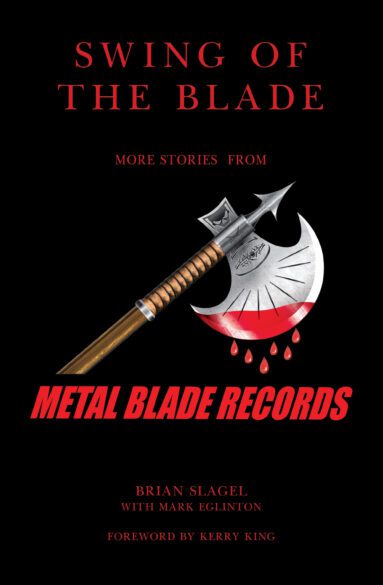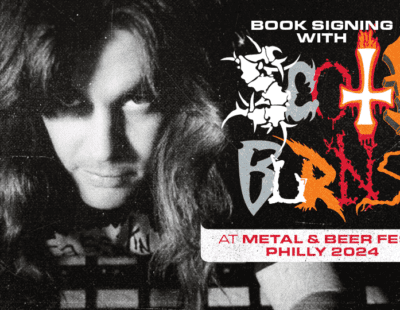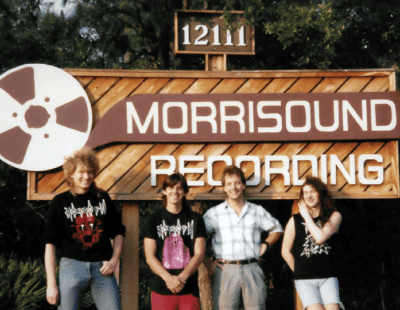
We couldn’t very well finish off our series of exclusive excerpts from Metal Blade Records founder Brian Slagel’s upcoming book, Swing of the Blade: More Stories from Metal Blade Records without a Metallica teaser. After all, the band made its first appearance on Metal Massacre way back in 1982, and Lars and James have been friends with Slagel going even further back. So this week we present a portion of the chapter “Always Friends,” with an insider’s look some turbulent times in Metallica’s history. If you want to read more, Swing of the Blade is set for a May 9 release and can be preordered here).

Always Friends
Inevitably a question people ask me what I think about various Metallica albums. I’m willing to accept that my views might be just a little controversial. I’m still a fan. I still have fan-like opinions!
Right off the bat I’ll say that if someone absolutely forced me to choose, Kill ‘Em All is one of my least favorite of the Metallica records. The reason? I just wasn’t a fan of James’s voice at the time. At that point, as hard as he was trying, he just couldn’t sing well, and he’d be the first to admit that he wasn’t totally comfortable with the role. I was even involved in the discussions about other options at the time because of my involvement with Armored Saint.
In the early 1980s, it was pretty clear to everyone, including Metallica, how great a singer John Bush was. I’d still have him in my top ten metal vocalists of all time, as you know. But at the time when Metallica were keen to get him to join (and they asked him many times), he was just too invested in Armored Saint to leave the guys he’d basically grown up with from childhood. They’d gone to grade school together. I know that John would have seen it as a huge wrench. Also, remember that at the time when these approaches were taking place, Armored Saint was arguably the bigger band.
They headlined on the same bill above Metallica at the Country Club in Reseda in 1983.
But by the time Ride The Lightning came along (spoiler alert: my favorite Metallica record), with James committed to vocal duties, everything came together. The songwriting was more mature, the musicianship was better and the production was on another level altogether. That was also the moment where I felt that James was really getting comfortable with his voice. He had that legendary Hetfield growl.
Every song on that record is an absolute classic: “Creeping Death,” “Trapped Under Ice”—the list goes on. The former has been my favorite Metallica song forever. It’s all classic stuff, except “Escape,” maybe, but that’s cool! On that subject, when they were doing Orion Festival for the first time in 2012 and playing Ride The Lightning in its entirety, I remember joking with James. “So . . . you’re finally going to play ‘Escape’ live tonight, yeah?”
He looked at me with a resigned expression, laughed and said, “Yeah, I guess . . . ”
I’m not sure if they ever really liked that song. And he admitted that day that they never, ever, intended to play it live. It was apparently a song that came together on the spur of the moment in the studio at the label’s behest. Really, I love all the music and respect how they’ve made bold decisions over the years. The records that have divided fan opinion were never a great surprise to me because I know where they came from because of my relationship with the band. As much as Load and ReLoad might have been challenging for some fans in the 1990s, it made total sense to me knowing what James’s taste in music is. He’s always been a fan of outlaw country and Southern rock. Those influences came out at that time
Similarly, St Anger—without question their most divisive record—was simply a product of those times. On one hand there was a lot of turmoil in the band. I saw it, and I also saw it being expressed in the music. On the other hand, because I was around them, I knew what kind of music they were listening to in 2002. Those influences are all over that record—and I respect that they’re always willing to make bold creative decisions and stand by them.
Death Magnetic was especially interesting for me specifically because at one point when they were writing it, Lars called me out of the blue.
“Hey, can you send me a bunch of New Wave Of British Heavy Metal stuff?” he said.
I got the impression that he and James had lost touch with some of that influence over the years and wanted to re-immerse themselves in that time and the sounds of it. I sent them a bunch of stuff. They really wanted to get back to their roots and you can really see that in the record.
Hardwired . . . To Self-Destruct felt like an extension of that process and I really love it, even though it took me longer than usual to hear the thing. Prior to its release, I was in New York at the same time as the band were having a listening party at Electric Ladyland studios, where everyone had to switch their phones off so nobody could record anything. I didn’t go, and Lars contacted me not long afterwards.
“Did you hear the record?” he said.
“Are you kidding me?” I said. “I can’t do without my phone for 80 minutes— especially during the day!”
Now, I genuinely consider it to be one of their best records and I thought it was quite a feat for arguably one of the biggest bands on the planet to go back to their roots and make a really heavy and aggressive record of that kind. It doesn’t sound like a rehash either, nor does it sound like just a bunch of old guys trying to recapture their youth again. It’s legit—and that’s because they’re still totally into it.
Take a song like “Spit Out The Bone,” for example. It is close to being the perfect song: the lyrics, the phenomenal leads, the way James sings it, the progressive elements—it’s the perfect heavy metal song for me and is in my top five all time Metallica songs of all time. When I first got the record I’m pretty sure I listened to that song a hundred times in a row. I frickin’ worship it.
The funny thing about this record is that it’s the only Metallica record that nobody can find anything to hate on. Historically, everybody, even fans, has found something to dislike about new Metallica music. People moaned about Ride The Lightning having acoustic guitars. Then there was no bass on . . . And Justice For All. Then they sold out on the Black album. Then there was the Load haircuts, and the St Anger drum sound. On and on it goes—there was always something. But with . . . Hardwired, there was nothing. Nobody could find anything to bitch about, and that says a lot about that record.
As I mentioned, over the years I’ve inevitably been around them when they’ve been recording and at some point in the process I’ve been in or around the studio.
Back in late 1990 and early 1991, they were recording Metallica in North Hollywood close to where I lived, and also close to our office in Sherman Oaks. During the year or so they were in One on One studios, I must have been in the studio with them on ten occasions and it was so convenient because my favorite sushi restaurant was close by. Whenever I was over in the area, I’d call them up and they’d say, “Sure, come in and say hey.”
I can recall a few interesting observations. The first was that they never really wanted anyone near the control room while they were recording. I totally understood that. They were working—and to have random people around would only have been a distraction. So I’d just hang out in the break room, catching snippets here and there with only the very occasional minute or two inside the actual room.
Looking back now, I totally respect their approach. I wouldn’t stand staring at a welder or a dentist while they’re working. The same applied to Metallica, regardless of my relationship with them. Instead, I just kept my head down and accepted their hospitality when they offered it.
Around this time, I believe they were still working on two-inch tape and as I’d worked on the production of some Metal Blade records, I was familiar with the studio environment and the whole concept of cutting tape, which was the method back then before Pro-Tools. I’d sit with engineers when they were cutting tape and I remember being terrified to do it myself in case I screwed something up.
Back in these days, it took much longer for a record to come out after it was finished being recorded. Design had to be concluded, vinyl had to be made and promo had to be geared up. Everything took so much longer. But I remember sitting in there with the band one day when they were discussing album art design and saying, “So when exactly is this album going to come out?”
“In about a month. We need to decide on album design right now.” I think it was James who replied.
“A month? How is that even possible?” I asked.
But they were Metallica. If they said they wanted a record out in a month, the label would say, “Ok, you guys. You got it. It’ll be out in a month.”
It was only afterwards that I got a sense of the magnitude of what they’d been doing for all that time in One on One. I remember Lars called me up one night while he was staying in North Hollywood. He had a cassette tape of the record and wanted me to hear it. Even before hearing anything, I could tell from his voice that he felt that they’d made a giant leap forward.
On first listen, my initial impressions were pretty mind-blowing. They definitely had made this huge step. He played me the whole record in sequence and paused after “Nothing Else Matters”—the song that perhaps most exemplified the extent of their development. For some reason it immediately made me think of a Jethro Tull song.
“What do you think?’ he said.
My relationship with Lars was such that I have no problem giving him an opinion, and that’s always been the case since. The reality is that there are probably very few people in their world who they trust enough to give them an honest judgment, and who isn’t just going to tell them what they want to hear. Ever since the early days, I’ve always been really honest with them about what I was hearing—as I was about “Nothing Else Matters.”
“The acoustic part reminds me of Jethro Tull . . . but I love it!” I’m honored that they ever want my opinion.
For a variety of reasons, I ended up being around Metallica most when they were recording St. Anger. I was around when James was gone. I ended up just hanging out with Lars while he was doing bits and pieces in the studio, not really knowing what was going to happen. There were some pretty deep and crazy conversations, let me tell you. Nobody knew what the future of the band was. Everything was up in the air at that point. Thankfully, as we all now know, it was resolved.
To read the rest of the “Always Friends” chapter, order Swing of the Blade here.






